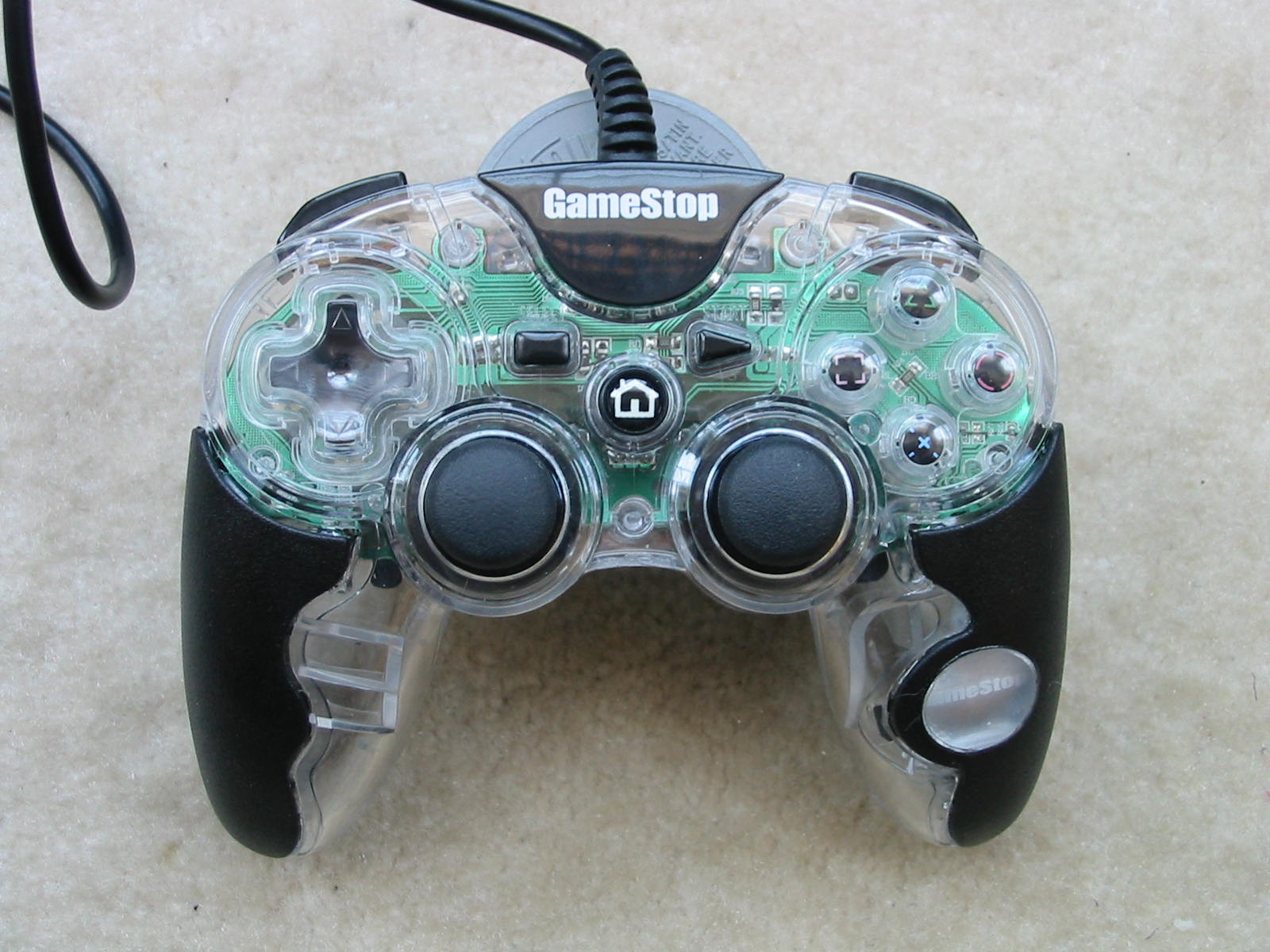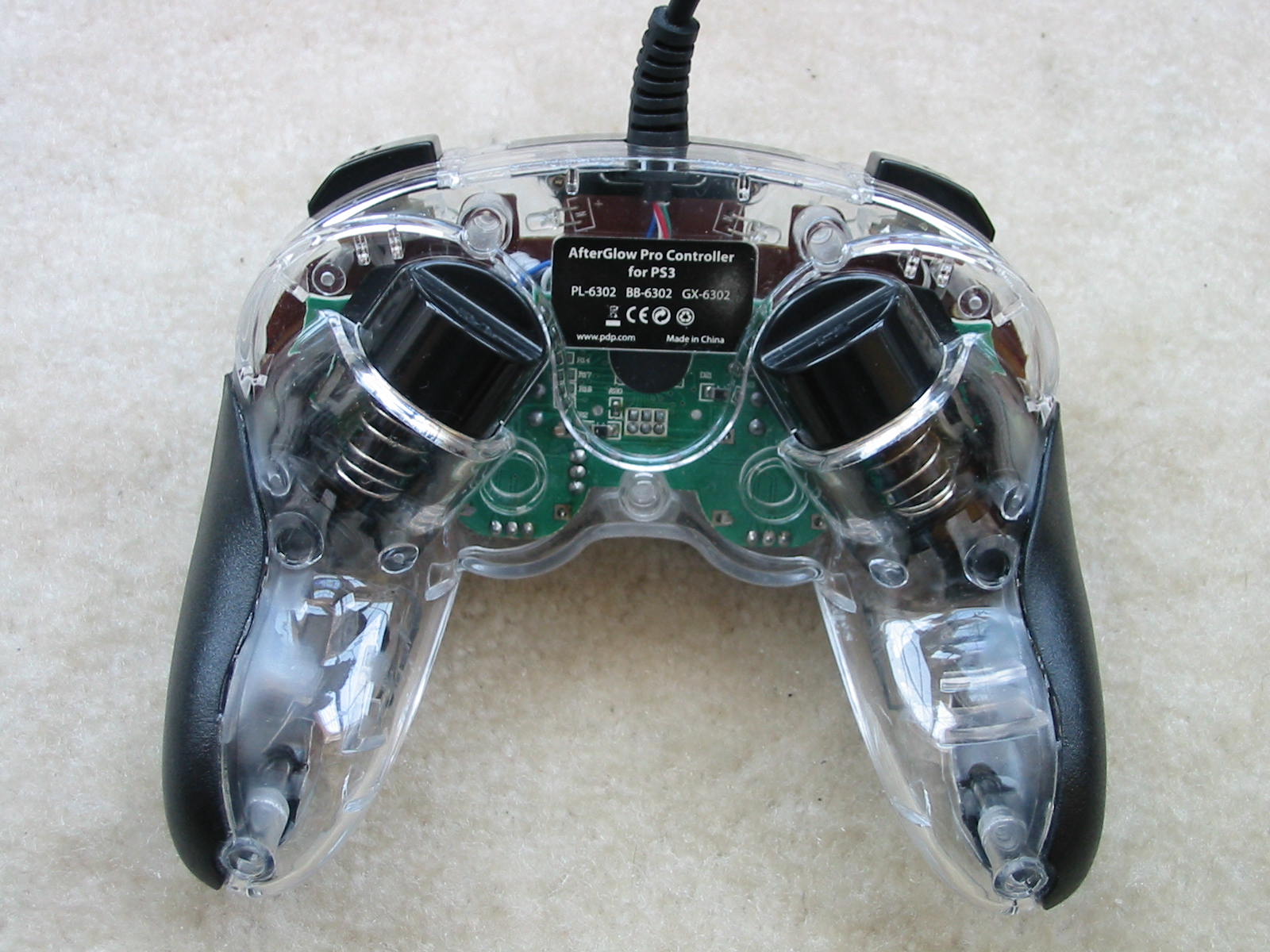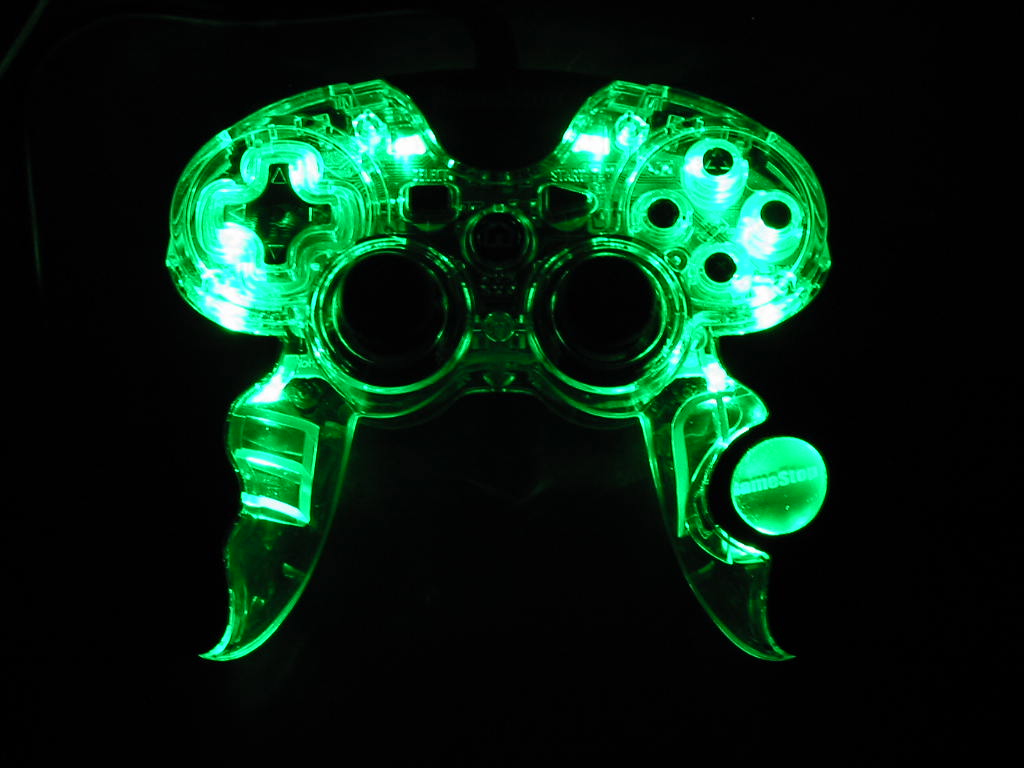Last year, I bought two of these AfterGlow Pro controllers (blue and green). At the time of buying, however, I couldn't find a coherent review anywhere on the Internet, much less an in-depth one. Thus, now that I've used them a bit (I played the entire game, The Last of Us with these), I think writing a review on these – even a non-professional one like mine - may be helpful to someone that is wondering if they should buy one of these or not. So here goes that.
I'll start with the good aspects. Starting with visuals, the see-through plastic used for the top part of these controllers makes them look attractive. The buttons have a smooth finish while the palm grips and analog joysticks have a matte, rubber-like coating. Here are two pictures of the top and bottom:


In terms of ergonomics, these controllers felt comfortable in my hands during testing. Moreover, since they are wired (thus lacking a battery) and also don't have Shock motors/vibrators, they are quite light-weight. And because they are wired, there is no need to worry about a battery running out during your game sessions.
But unfortunately, that is about all there is to the good aspects. Now for the bad ones… I don't even know where to start here. But let's continue with the visual aspects for now. While these controllers look very cool during the day with their bright LED lights, they are an eye-sore to use at night or in a dark room – quite literally! The LEDs inside these controllers are not angled very well (if at all), and so both of my controllers were emitting strong light through the see-through case in all sorts of random directions. With the internal reflections of the clear case, there were quite a few angles where the LED light was directly beamed towards my eyes. I was using the green controller at first, as I thought it would be less annoying, but both were equally irritating. After playing through the The Last of Us for a couple of hours late one night, I quickly got fed up with these controllers and resorted to removing pretty much all of the LEDs in the green controller before I deemed it acceptable. With all of the LEDs in it originally, it was just too bright. Worth noting here (at least for the technical folks) is that each LED is connected to the 5V USB power bus individually through a 200-Ohm series resistor. This is why the LEDs were so bright. Technically, I could make the LEDs dimmer if I change the resistors. But in the end, I didn't feel like bothering with that and just removed them altogether.
So here is how the green controller looked like in the dark originally before I removed its LEDs:

https://www.badcaps.net/forum/attach...1&d=1505073453
https://www.badcaps.net/forum/attach...1&d=1505073453
https://www.badcaps.net/forum/attach...1&d=1505073453
Moving away from visuals, I would like to add as a final note on that matter, that while the controller case looks nice, one can tell it is a cheap controller if looked upon closely. In particular, the plastics of the top and bottom parts of the case don't line up too well, thus giving the controller a “rough” feel. The USB cable that connects the controller to the PS3 also feels cheap, as it is very stiff and will remain in an ugly shape.
And now for the most important part: the mechanics/ergonomics.
I'll start with the analog joysticks, as they are probably the most notable aspect in regards to the quality (or lack thereof) of this controller. The analog joysticks feel cheap (and they are!), as one might expect from a cheap controller. In particular, their “analog” range is quite narrow, meaning there is a very small zone where the controller distinguishes the joystick as “slightly pushed” to “fully pushed”. Thus, aiming in shooting games like The Last of Us was not easy at all, as I couldn't do any precise aiming. When I started the game, I decided to try it out on the Normal setting. But after struggling for an hour of gameplay (especially when I had to aim a weapon), it was obvious that I needed to switch the game to Easy mode, as there was no other way I would have finished it. (On Easy mode, the game has enemy aim-lock, so the PS3 pretty much does all the aiming for you once you point in the direction you want to aim.) However, I will also admit that I have never played a shooting game on a console before this, so my “noob” joystick skills made the issue even more aggravating. That said, even by the end of the game (when I got much more comfortable with the PS3 joystick), I still struggled with auto-aim off when I tried it a few times, as I still couldn't do any fine aiming. So to sum up what I said about the analog joysticks: they are cheap. They may be okay for more basic games, but certainly don't expect to get an enjoyable experience in shooter games.
Next item on the list are the L2 and R2 buttons. The L2 and R2 buttons on these AfterGlow controllers have a very rough travel and I could easily hear the springs grinding against the plastics inside the button. Moreover, it was possible to make the L2 and R2 buttons get stuck if not pressing them the right way. Fortunately, I was able to correct this issue by rubbing some machine oil on the springs and button plastics where they slid in the case. This completely dealt away with the L2 and R2 travel issues and the springs did not make loud clacking noises anymore. Of course for people that don't feel comfortable with opening/servicing their stuff, the rough L2 and R2 buttons would be another issue they have to deal with.
But apart from the analog joysticks and L/R2 buttons, the rest of the buttons on the controller are alright, especially for the price range of these controllers. All of the regular buttons on the controller use rubber-dome switches. The rubber domes are a bit stiff and also a bit loud when being de-pressed and released. But they work reliably, so I can't complain here.
Finally, here are several pictures of the controller disassembled.
https://www.badcaps.net/forum/attach...1&d=1505073453
https://www.badcaps.net/forum/attach...1&d=1505073453
https://www.badcaps.net/forum/attach...1&d=1505073453
https://www.badcaps.net/forum/attach...1&d=1505073453
https://www.badcaps.net/forum/attach...1&d=1505073475
In terms of electrical/internal built quality, these controllers are, again, not bad for the price they go for. The good thing is that both PCBs inside the controller are single-layer, thus making it easy to trace things and perhaps even do some mods (in my case, desolder the LEDs with ease). On that note, the controller's plastic case does have provisions for two vibration motors. So if one could figure where to connect the motors on the PCB, the controllers could be modded to have dual-Shock technology. However, with the main controller chip being a COB (chip-on-board) encased in black epoxy, this would probably make user-modding much harder (if not nearly impossible).
So all in all, these GameStop AfterGlow Pro controllers are okay for the money. While they may not be suitable for playing sophisticated games (especially shooter games), they are certainly alright for basic games and/or just to have as a spare for testing PS3 consoles. On that note, and perhaps this may not be important to all games, but I forgot to mention that both of the AfterGlow Pro controllers I got did not come equipped with motion-sensing technology that the genuine PS3 controllers have. So one may have trouble playing certain games if they are dependent on that feature. Thus, if one can get a genuine PS3 controller for a decent price, I would certainly recommend going with that over buying one of these cheap aftermarket controllers. But other than that, I can't say that my purchase of the AfterGlow Pro controllers was a bad idea. They worked okay and I was able to finish The Last of Us, so overall I am very happy.
I'll start with the good aspects. Starting with visuals, the see-through plastic used for the top part of these controllers makes them look attractive. The buttons have a smooth finish while the palm grips and analog joysticks have a matte, rubber-like coating. Here are two pictures of the top and bottom:
In terms of ergonomics, these controllers felt comfortable in my hands during testing. Moreover, since they are wired (thus lacking a battery) and also don't have Shock motors/vibrators, they are quite light-weight. And because they are wired, there is no need to worry about a battery running out during your game sessions.
But unfortunately, that is about all there is to the good aspects. Now for the bad ones… I don't even know where to start here. But let's continue with the visual aspects for now. While these controllers look very cool during the day with their bright LED lights, they are an eye-sore to use at night or in a dark room – quite literally! The LEDs inside these controllers are not angled very well (if at all), and so both of my controllers were emitting strong light through the see-through case in all sorts of random directions. With the internal reflections of the clear case, there were quite a few angles where the LED light was directly beamed towards my eyes. I was using the green controller at first, as I thought it would be less annoying, but both were equally irritating. After playing through the The Last of Us for a couple of hours late one night, I quickly got fed up with these controllers and resorted to removing pretty much all of the LEDs in the green controller before I deemed it acceptable. With all of the LEDs in it originally, it was just too bright. Worth noting here (at least for the technical folks) is that each LED is connected to the 5V USB power bus individually through a 200-Ohm series resistor. This is why the LEDs were so bright. Technically, I could make the LEDs dimmer if I change the resistors. But in the end, I didn't feel like bothering with that and just removed them altogether.
So here is how the green controller looked like in the dark originally before I removed its LEDs:
https://www.badcaps.net/forum/attach...1&d=1505073453
https://www.badcaps.net/forum/attach...1&d=1505073453
https://www.badcaps.net/forum/attach...1&d=1505073453
Moving away from visuals, I would like to add as a final note on that matter, that while the controller case looks nice, one can tell it is a cheap controller if looked upon closely. In particular, the plastics of the top and bottom parts of the case don't line up too well, thus giving the controller a “rough” feel. The USB cable that connects the controller to the PS3 also feels cheap, as it is very stiff and will remain in an ugly shape.
And now for the most important part: the mechanics/ergonomics.
I'll start with the analog joysticks, as they are probably the most notable aspect in regards to the quality (or lack thereof) of this controller. The analog joysticks feel cheap (and they are!), as one might expect from a cheap controller. In particular, their “analog” range is quite narrow, meaning there is a very small zone where the controller distinguishes the joystick as “slightly pushed” to “fully pushed”. Thus, aiming in shooting games like The Last of Us was not easy at all, as I couldn't do any precise aiming. When I started the game, I decided to try it out on the Normal setting. But after struggling for an hour of gameplay (especially when I had to aim a weapon), it was obvious that I needed to switch the game to Easy mode, as there was no other way I would have finished it. (On Easy mode, the game has enemy aim-lock, so the PS3 pretty much does all the aiming for you once you point in the direction you want to aim.) However, I will also admit that I have never played a shooting game on a console before this, so my “noob” joystick skills made the issue even more aggravating. That said, even by the end of the game (when I got much more comfortable with the PS3 joystick), I still struggled with auto-aim off when I tried it a few times, as I still couldn't do any fine aiming. So to sum up what I said about the analog joysticks: they are cheap. They may be okay for more basic games, but certainly don't expect to get an enjoyable experience in shooter games.
Next item on the list are the L2 and R2 buttons. The L2 and R2 buttons on these AfterGlow controllers have a very rough travel and I could easily hear the springs grinding against the plastics inside the button. Moreover, it was possible to make the L2 and R2 buttons get stuck if not pressing them the right way. Fortunately, I was able to correct this issue by rubbing some machine oil on the springs and button plastics where they slid in the case. This completely dealt away with the L2 and R2 travel issues and the springs did not make loud clacking noises anymore. Of course for people that don't feel comfortable with opening/servicing their stuff, the rough L2 and R2 buttons would be another issue they have to deal with.
But apart from the analog joysticks and L/R2 buttons, the rest of the buttons on the controller are alright, especially for the price range of these controllers. All of the regular buttons on the controller use rubber-dome switches. The rubber domes are a bit stiff and also a bit loud when being de-pressed and released. But they work reliably, so I can't complain here.
Finally, here are several pictures of the controller disassembled.
https://www.badcaps.net/forum/attach...1&d=1505073453
https://www.badcaps.net/forum/attach...1&d=1505073453
https://www.badcaps.net/forum/attach...1&d=1505073453
https://www.badcaps.net/forum/attach...1&d=1505073453
https://www.badcaps.net/forum/attach...1&d=1505073475
In terms of electrical/internal built quality, these controllers are, again, not bad for the price they go for. The good thing is that both PCBs inside the controller are single-layer, thus making it easy to trace things and perhaps even do some mods (in my case, desolder the LEDs with ease). On that note, the controller's plastic case does have provisions for two vibration motors. So if one could figure where to connect the motors on the PCB, the controllers could be modded to have dual-Shock technology. However, with the main controller chip being a COB (chip-on-board) encased in black epoxy, this would probably make user-modding much harder (if not nearly impossible).
So all in all, these GameStop AfterGlow Pro controllers are okay for the money. While they may not be suitable for playing sophisticated games (especially shooter games), they are certainly alright for basic games and/or just to have as a spare for testing PS3 consoles. On that note, and perhaps this may not be important to all games, but I forgot to mention that both of the AfterGlow Pro controllers I got did not come equipped with motion-sensing technology that the genuine PS3 controllers have. So one may have trouble playing certain games if they are dependent on that feature. Thus, if one can get a genuine PS3 controller for a decent price, I would certainly recommend going with that over buying one of these cheap aftermarket controllers. But other than that, I can't say that my purchase of the AfterGlow Pro controllers was a bad idea. They worked okay and I was able to finish The Last of Us, so overall I am very happy.

 !?!?!?! $60 for a USED controller????
!?!?!?! $60 for a USED controller???? 

 (Okay, I didn’t actually say it like that
(Okay, I didn’t actually say it like that  )
)

Comment